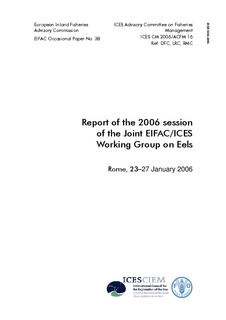| dc.description.abstract | This publication is the report of the 2006 session of the Joint European Inland Fisheries Advisory Commission (EIFAC) and International Council for the Exploration of the Sea
(ICES) Working Group on Eels which was held in Rome from 23 to 27 January 2006. The Working Group, after reviewing the available information on the status of the stock and
fisheries of the European eel, supported the view that the population as a whole has declined in most of the distribution area, that the stock is outside safe biological limits and that current
fisheries are not sustainable. Recruitment is at a historical low and most recent observations do not indicate recovery. Opportunities for protection and restoration of spawner escapement are
fading.
Earlier reports indicate that anthropogenic factors (e.g. exploitation, habitat loss, contamination and transfer of parasites and diseases) as well as natural processes (e.g. climate
change, predation) may have contributed to the decline. Measures aimed at recovery of the stock are well known and may include control of exploitation, restocking of recruits and
restoration of habitats (including access to and from).
Recent research shows that the quality of the spawners escaping from the continent might be seriously impaired by pollution, diseases and parasites. Additionally, the quality of spawners
varies with biological characteristics such as size and fat content. None of these quality parameters is currently included in the assessment of the status of the stock or in setting
management targets. Implementation of basic field sampling programmes, i.a. within the EU Water Framework Directive (WFD) and National Management Plans, and further analysis will
be required, in order to include quality aspects in future management advice. The objective of recovery of the stock necessitates restoration of the spawning stock, for
which the European Commission has proposed a target of 40% of the potential production under unfished, unpolluted and unobstructed conditions. Methodology for elaboration of this
reference level is described, but actual implementation requires field data and analysis for each spatial management unit. Analysis of stock dynamics under different fisheries
management regimes indicates that recovery times may vary from 20 up to 200 years, depending on the intensity of implemented fisheries restrictions. However, restrictions on
fisheries alone will be insufficient, and management measures aimed at other anthropogenic impacts on habitat quality, quantity and accessibility will also be required.
The continental population extends throughout Europe and northern Africa and fisheries are scattered over many large and small water bodies, both marine and freshwater. The overall
objective will have to be achieved by implementation of protective measures at a regional scale, presumably at the level of River Basin Districts (RBDs as defined for the WFD). The
compilation of information on the spatial distribution of the current eel fisheries in this report shows that almost all RBDs will be involved. Spatial differentiation in targets, controls and
post-evaluation procedures might facilitate the implementation.
Restocking has been practised by some countries for decades, generally to maintain fisheries rather than improve the stock or recruitment. There are concerns over the unknown risks of
moving fish between rivers. Restocking may be beneficial to rebuilding the stock, but it is highly unlikely that the 40% objective will be met in all European river basins in the medium
term by restocking alone. Only a combination of several measures can be expected to bring the stock out of its current critical state. The current glass eel catches are probably insufficient
to restock inland waters, and any further decline in glass eel recruitment could result in total loss of the option to use restocking as a measure.
Recommendations to protect the stock, and suggestions for a forward focus of the work of this group are presented. | en_US |
